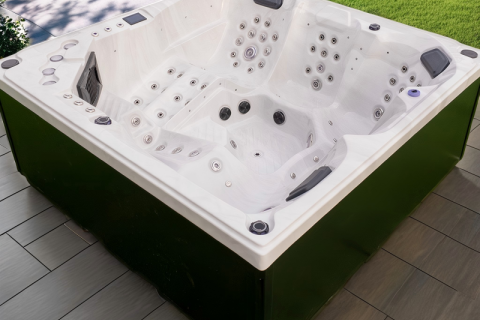
- Home
- >
News
Acrylic spa hot tubs can indeed yellow under adverse operating conditions, improper cleaning and maintenance, or due to material aging. Causes include material aging, mineral deposits in the water, UV exposure, and improper cleaning. However, acrylic, as a relatively stable thermoplastic material, retains its color well under normal use.
Advantages of acrylic spa hot tubs: 1. Lightweight and easy to install 2. Excellent thermal insulation 3. Smooth and comfortable surface 4. Attractive appearance and strong plasticity 5. Easy to clean and maintain 6. Reasonable cost and high cost-effectiveness Disadvantages of Acrylic Spa Hot Tubs: 1. Surface easily scratched 2. Limited high-temperature resistance 3. Susceptible to aging and discoloration 4. Less load-bearing than heavier materials 5. Limited environmental friendliness and recyclability
Acrylic spa hot tubs have some resistance to staining, but their hardness and stain resistance are not as good as those of ceramic or enamel products. Therefore, if improperly cared for, they can easily stain under certain conditions.
High-Frequency Outdoor Use (2-4 People) · Recommended Thickness: 6mm-8mm · Reason: Outdoor temperatures fluctuate significantly, water depths are higher, and the structure withstands greater pressure. Thick acrylic effectively prevents stress cracks and surface deformation caused by thermal expansion and contraction.
While values vary between manufacturers, based on industry standards, it is generally accepted that: · The load-bearing limit for a standard 2- to 4-person acrylic spa tub is 1000-1200 kg · The load-bearing limit for a medium- to large-sized 6-person tub is 1600-2000 kg · Custom-made luxury acrylic spa tubs can withstand loads exceeding 2500 kg.
Improper installation is one of the primary factors that lead to repeated cracking in acrylic spa tubs: · The bottom of the tub is not fully in contact with the ground, resulting in uneven stress concentration in the suspended area; · Failure to use appropriate foam fillers or support frames; · Failure to account for minor unevenness in the wall or floor tiles during installation, leading to abnormal pressure points in the tub.
For common black scuff marks, you can choose a commercially available acrylic cleaner or a neutral, non-abrasive all-purpose cleaner: Steps: · Clean the stained area with a damp, soft cloth; · Spray the cleaner onto the black mark; · Gently rub with a microfiber cloth or sponge in a circular motion; · Rinse with warm water and wipe dry.
Acrylic spa bathtubs: A thick layer of acrylic (usually 2-5mm thick) is visible, with a fiberglass reinforcement layer underneath. Fiberglass bathtubs: The overall surface is thinner, with no visible acrylic panels. The interior is often a one-piece glass fiber composite material.
Thoroughly clean the acrylic spa bathtub with warm water and a neutral detergent: · Clean the surface thoroughly with a soft cloth, especially around the nozzles and crevices; · If scale is present, soak the area with a 1:1 mixture of white vinegar and water before wiping; · Avoid using harsh, corrosive cleaners containing chlorine, ammonia, or ethanol.
Maintaining cleanliness is fundamental to maintaining an acrylic spa tub and the first step to preventing material aging and system failure. 1. Frequency of Use and Cleaning Recommendations Daily Use: Clean after each use 2-3 times a week: Clean twice a week Occasional Use: Clean after each use
Acrylic spa tub crack repair process Step 1: Clean the cracked area Step 2: Sand the surface Step 3: Apply repair agent Step 4: Natural or heat cure Step 5: Fine sanding and polishing Step 6: Apply protective oil
1. Under standard operating conditions, high-quality acrylic spa hot tubs generally will not experience structural failure within 10 years; 2. Mid-range products may develop cracks or structural fatigue after 5 to 8 years; 3. If improperly installed or used, low-end tubs may break after 3 to 5 years; 4. Proper maintenance and repair can delay breakage by at least 3 to 5 years.












